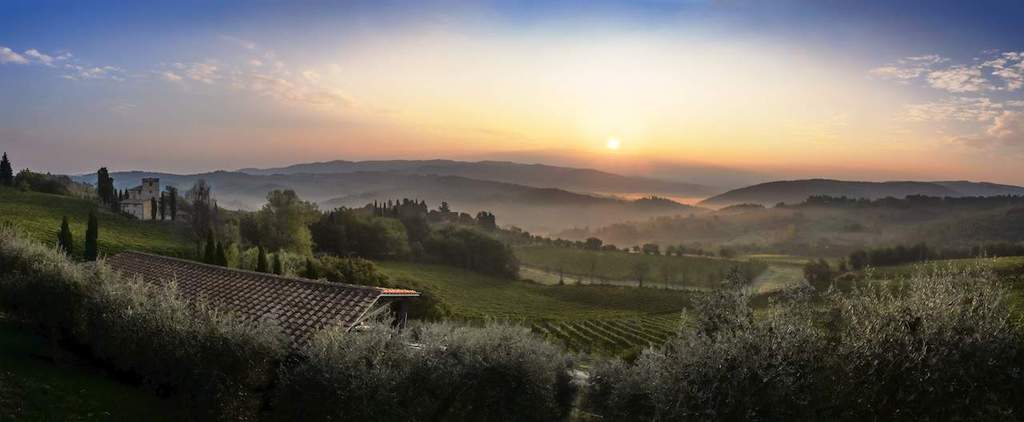My left hand gripped the steering wheel of the rented Alfa Romeo just a bit harder as I downshifted from third into second, eased off the gas and managed to avoid the scooters that were dive bombing into yet another roundabout while departing Florence. I prayed that the Mini tailgating me didn’t slam into my rear end. The ever calm and collected British-accented woman’s voice on my GPS cooed, “Take the third exit off the roundabout.” I call her Olivia.
With intense concentration, I shifted back into third, hit the accelerator and dove across traffic that seemed oblivious to my existence, toward the exit Olivia had indicated. Stomping the clutch, shifting to fourth and accelerating away from yet another hair-raising roundabout, Olivia calmly told me to enter the Autostrada in 500 meters. I easily merge into light traffic. On the straight road my nerves calmed. Sadly, the speed limit here is only 110 kph, which the Alpha is easily handling in fourth gear, but I’d like to open this baby up and see what she could really do.
In less than half an hour Olivia told me to exit onto the country highway and begin the climb upwards into Chianti Classico. The hills here differ from the gently rolling hills common to Tuscany. Here they are steeper and the soil in the vineyards is rockier.
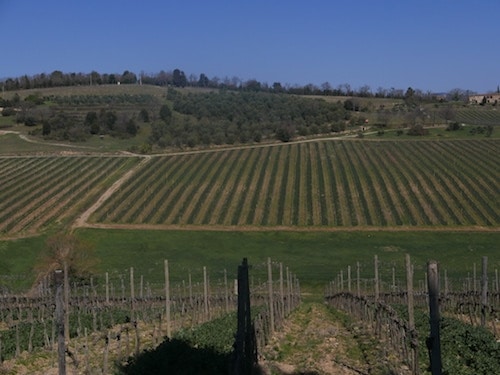
The area looks very much like Northern California, only older. Sort of like the difference between a well-worn and loved leather jacket and a brand new one. Also, unlike California where massive stretches of pastureland or vineyard extend for as far as the eye can see; here in Italy, the landscape is a patchwork of olive grove, vineyard, pasture, and field. This polyculture is symbiotic, and it makes the earth and its people happy. It’s truly Italian and is just one of many features of the place that makes a visit to Chianti Classico worth the journey.
Where is Chianti Classico?
This famed, yet often misunderstood wine region has historically played second fiddle to neighboring Brunello di Montalcino and later to the Super Tuscan wines of Bolgheri. Maligned by the reputation of making cheap characterless wines sold in fiasco bottles, Chianti Classico has long fought an uphill battle. But don’t underestimate the wines made here, they’re some of the greatest values available in the wine world.
RELATED: Learn All About the Wine Region of Tuscany
One of the primary battles the wines of Chianti Classico have fought is that they’ve commonly been seen as one and the same as Chianti. The difference between the two can be confusing. It begins with geography. Chianti can be made from grapes grown in a variety of areas throughout Tuscany surrounding the Chianti Classico region. Chianti can be grown in the Tuscan regions of Arezzo, Florence, Pisa, Pistoia, Prato and Siena.
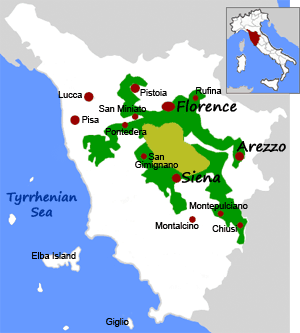
Chianti Classico is defined as the area stretching from Florence in the north, south almost all the way to Siena and includes the communes of Castellina in Chianti, Gaiole in Chianti, Greve in Chianti and Radda in Chianti as well as parts of Barberino Tavarnelle, Castelnuovo Berardenga, Poggibonsi, and San Casciano Val di Pesa.
RELATED: 5 Day Itinerary For Exploring Tuscany’s Chianti Region
The Tale of the Black Rooster
Legend has it that the borders of this area were defined not by war, but by an unusual contest.
Back in the 13th century, the region now known as Chianti Classico was in constant dispute between the city-states of Florence and Siena. In order to determine where the true border lay without war, it was decided that on a certain day, when the cock crowed, riders from Florence and Siena would set off along the road. When they met, that’s where the border would be drawn. The Florentines were crafty however, and decided to take an old angry black rooster, starve it for a few days, keep it awake for a few days, and set it free long before dawn on the morning of the ride. Well, the bird was so agitated that it crowed immediately upon release, long before the crack of dawn. Thus, the Florentine rider set off. By the time dawn had come and the rider from Siena had begun his ride, the rider from the north had covered most of the distance to Siena. When they met, they were within just 20 km of the walls of Siena. Thus, the black rooster became the symbol of Chianti Classico.
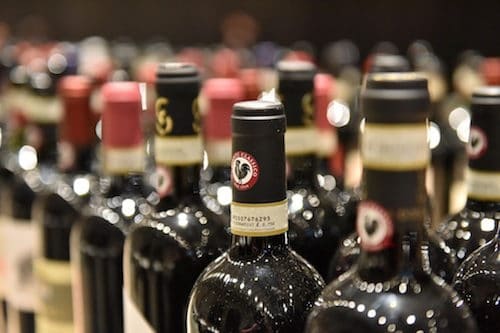
Forgery and Self-Mutilation
Wine from this region was favored in England going back to the 16th century. Sadly, because of the demand for these wines, by the late seventeenth century, fraudulent cheap wines falsely claiming to be from this area tarnished its reputation.
Centuries later in the mid-1800s the wines of Chianti engaged in another fight of mediocrity, it was then, that the Baron Ricasoli fought to add small amounts of Malvasia to make the wines more drinkable early. This was the beginning of a long road to yet another loss of reputation, and not without reason. While making Chianti more drinkable while young initially made them more popular, soon other white grapes were added, including the characterless Trebbiano Toscano. Up to as much as 30 percent of white grapes were eventually allowed in the blend. This practice turned the wines anemic and dull. This continued until the 1970s. It wasn’t until 1984 that Chianti Classico was granted a D.O.C.G. and was able to separate itself from the rest of Chianti.
Reinventing Quality
Today using white grape varieties in Chianti Classico wines is forbidden, while in Chianti wines up to 10% are still allowed. The other main difference in vinification is that Chianti must be 70% Sangiovese, while Chianti Classico requires a minimum of 80% Sangiovese. Chianti requires a minimum of three months aging before bottling and Chianti Classico a minimum aging of 10 months.
In the vineyards of Chianti Classico farmers are increasingly using organic practices. According to Giovani Manetti of Fontodi, and the current president of the Consorzio Vino Chianti Classico, “Currently over 90 percent of vineyards in Chianti Classico are using at least some part of organic growing practices.” It’s this traditional respect for the land that helps define the wines of Chianti Classico and give them terroir-driven qualities. This care in the vineyard combined with modern winemaking advances, make wines from Chianti Classico an amazing value today.
The Wines of Chianti Classico
Wine from Chianti Classico can be classified into three different categories.
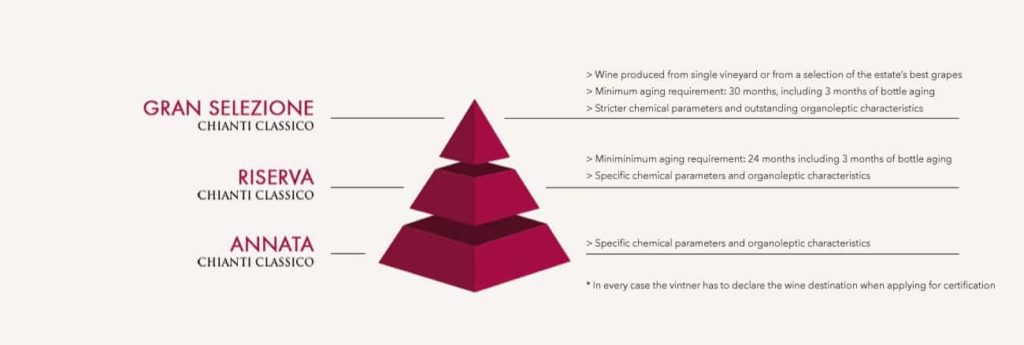
The base of the pyramid is Chianti Classico, and like all Chianti Classico, this must be a minimum of 80% Sangiovese, have at least 12 months of aging prior to bottling, and be at least 12% alcohol.
The mid-tier of wine on the pyramid of Chianti Classico is Riserva. Riserva wines must be aged a minimum of 24 months followed by an additional three months of bottle aging. They must contain a minimum of 12.5 % alcohol.
The pinnacle of Chianti Classico wines is Gran Selezione. These wines must be made from the best fruit grown on an estate-owned single-vineyard and must be aged for a minimum of 30 months, plus an additional three months of bottle aging. Gran Selezione wines must contain at least 13% alcohol.
In Chianti Classico, like in all of Italy, wine is more than a beverage, it’s thought of as food, a necessity for life. This is simply one of the reasons Chianti Classico pairs perfectly with the cuisine of Tuscany. The high acidity of the wines provides a perfect foil for the rich, boldly flavored meats of cinghiale, roe deer, and pheasant, all of which are pervasive in the region. These wines drink beautifully while young, but when you get to Riserva or Gran Selezione, can age and improve in your cellar for decades to come. Salute!
More Italian Travel Guides and Travel Inspiration
Discover Central Italy: A Wine & Food Lover’s Travel Guide
10 Charming Italian Towns To Visit if You Love Food and Wine
San Marino 2 Day Itinerary: Complete Travel Guide
Cinque Terre Italy Itinerary: Travel Guide For Wine Lovers
10 Best Authentic Things To Do When Visiting Naples Italy
You are reading “Chianti Classico Wine: History, Intrigue & Regional Styles” Back To Top
difference between Chianti and Chianti Classico, Italian wine: Sardinia wine region
If you enjoyed this guide, consider joining the Facebook Group to interact with other Winetravelers and for travel inspiration around the world, and be sure to follow along with us on Instagram.
